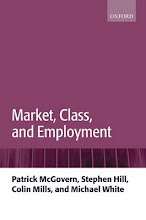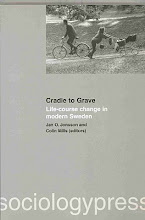Last time around on this theme. It seems to me that a fair amount of silliness has emerged in the discussion of what drove the Brexit vote. Two moves seem popular, neither of which are terribly enlightening. One is to condition on the outcome and then ask what are the people who voted Out like? There is nothing inherently wrong with this, it answers a perfectly well defined question, just not the scientific question of interest. The problem is that p(c_1, c_2, c_3...| y_1) where c_1 etc is a characteristic - class, gender, vote preference - and y_1 is Brexit vote is influenced by the marginal distribution of the characteristics. What you actually want is p(y_1| c1, c2,c_3...).
The second move I've observed is to argue that Brexit voting isn't really a matter of social structure at all, but has to do with holding certain attitudes. As I showed in my first post it is certainly true that holding certain attitudinal views - on immigration, political inclusion and welfare is strongly correlated with views about the EU. However it is quite another thing to argue that one causes the other. Certainly it is not wise to condition on an endogenous attitudinal variable and then claim that this shows that social structure doesn't matter. You need to consider both indirect and direct effects and it has something of the flavour of saying - to steal the words of a very perceptive sociological colleague - "God did it" (hat tip to BTH). Sometimes, as I say to my students, you don't want an explanatory variable that is too close to the dependent variable.
So this brings me around to my last bit of empirics on the subject. Again I'm using the 2015 BES cross-section with the same measure of attitude to the EU the construction of which I described in my previous post, but simplified so that I only consider the contrast between those that are supportive of the EU and those that are anti EU (I drop the ambivalent). I estimate a linear model for the probability of being anti EU with fixed effects for the 300 odd constituencies in the sample. I control for age and gender. I'm interested in: 1) coefficient for socio-economic characteristics of the respondents ( occupation, household-income and whether or not they are a graduate) mainly so we can get some idea of the magnitude of the differences between groups; 2) getting some idea of the predictive impact of these characteristics.
In case the binary regression police are watching I should say that if you estimate a conditional logit model with fixed effects you will draw exactly the same substantive conclusions (but feel slightly better about your standard errors).
So, if you estimate this regression with just the fixed effect and a constant you "explain" about 20% of the variance. I don't recommend this as a way to estimate a variance component - but I need some sort of baseline against which to evaluate the contribution of the individual level predictors. Next throw in the demographics -age and gender. That "explains" 21%. Add in the socio-economic predictors - occupation, income and graduate status - and this leaps up to 35%. However you look at it adding more socio-economic structure improves the prediction by a substantial amount.
Let's look at the estimated slope coefficients and associated t values. These are shown in the columns headed (1) in the table below (the fixed effects and demographic controls are in the model but I don't show them here).
Controlling for the constituency fixed effects and the demographics, occupation, income and being a graduate all capture substantively important differences in the propensity to be anti EU. Being self-employed or working class makes you more anti, as does having a low household income, and being a non-graduate.
Consider the magnitude of the estimated % point difference in taking an anti-EU stance for two typical cases. The conditional average difference between a graduate higher manager with a household income in the £40,000-£74,999 bracket and a working class, non graduate with household income in the £15,600-£39,000 bracket: it's 39 percentage points. Assuming that these data have some bearing on people's behaviour in June 2016, then anyone who wants to argue that something like social class is a minor factor has some explaining to do.
But let's test the case for individual level socio-economic differences a bit more. Does it stand up even if we condition on an obviously endogenous variable like party voted for in the 2015 General Election? The columns labelled (2) hold the answer. And it is, broadly speaking, yes. Controlling for political preference (and in fact participation) doesn't really change anything very much. We get a similar outcome if we condition on the, again obviously endogenous, attitudinal variables - towards immigration, politics and welfare - that I discussed in my last two posts. The socio-economic coefficients shrink slightly towards zero, but they don't go away.
It may be the case that something like class dealignment has happened with regard to party choice, but that does not imply that "class" per se is dead.
"As surely as Water will wet us, as surely as Fire will burn,
The Gods of the Copybook Headings with terror and slaughter return!"











No comments:
Post a Comment